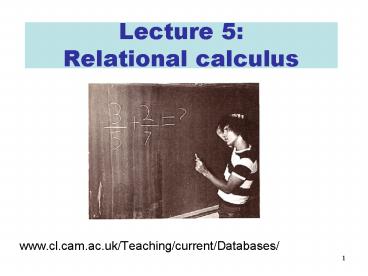Lecture 5: Relational calculus - PowerPoint PPT Presentation
Title:
Lecture 5: Relational calculus
Description:
Relational calculus. There are two versions of the relational calculus: ... The calculus is non-procedural ( declarative') compared to the relational algebra ... – PowerPoint PPT presentation
Number of Views:114
Avg rating:3.0/5.0
Title: Lecture 5: Relational calculus
1
Lecture 5Relational calculus
- www.cl.cam.ac.uk/Teaching/current/Databases/
2
Relational calculus
- There are two versions of the relational
calculus - Tuple relational calculus (TRC)
- Domain relational calculus (DRC)
- Both TRC and DRC are simple subsets of
first-order logic - The difference is the level at which variables
are used for fields (domains) or for tuples - The calculus is non-procedural (declarative)
compared to the relational algebra
3
Domain relational calculus
- Queries have the form ltx1,,xngt F(x1,,xn)
where x1,,xn are domain variables and F is a
formula with free variables x1,,xn - Answer all tuples ltv1,,vngt that make F(v1,,vn)
true
4
Example
- Find all sailors with a rating above 7
- ltI,N,R,Agt ltI,N,R,Agt?Sailors ? Rgt7
- The condition ltI,N,R,Agt?Sailors ensures that the
domain variables are bound to the appropriate
fields of the Sailors tuple
5
Example
- Simple projection ltI,Ngt ?R,A.ltI,N,R,Agt?Sailo
rs - Simple projection and selection ltI,Ngt
?R,A.ltI,N,R,Agt?Sailors ? NJulia
6
DRC formulae
- Atomic formulae a
- ltx1,,xngt?R
- xi binop xj, xi binop c, c binop xj, unop c, unop
xi - DRC Formulae P, Q
- a
- ?P, P?Q, P?Q
- ?x.P
- ?x.P
- Recall that ?x and ?x are binders for x
7
Example
- Find the names of sailors rated gt7 whove
reserved boat 103 - ltNgt ?I,A,R.ltI,N,R,Agt?Sailors ?
- Rgt7 ? ?SI,BI,D.(ltSI,BI,Dgt?Re
serves ? ISI ?
BI103) - Note the use of ? and to simulate join
8
Example
- Find the names of sailors rated gt7 whove
reserved a red boat - ltNgt ?I,A,R.ltI,N,R,Agt?Sailors ?
- Rgt7 ? ?SI,BI,D.
(ltSI,BI,Dgt?Reserves ?
SII ? ?B,C.
(ltB,Cgt?Boats ? BBI ?
Cred))
9
Example
- Find the names of sailors who have reserved at
least two boats
ltNgt ?I,R,A. ltI,N,R,Agt?Sailors ?
?BI1,BI2,D1,D2.ltI,BI1,D1gt?Reserves ?
ltI,BI2,D2gt?Reserves ?
BI1?BI2
10
Example
- Find names of sailors whove reserved all boats
11
Example
- Find names of sailors whove reserved all boats
ltNgt ?I,R,A. ltI,N,R,Agt?Sailors ? ?B,C.
(?(ltB,Cgt?Boats) ?
(?ltSI,BI,Dgt?Reserves.
ISI ? BIB))
ltNgt ?I,R,A. ltI,N,R,Agt?Sailors ?
?ltB,Cgt?Boats. ?ltSI,BI,Dgt?Reserves.
ISI ? BIB))
12
Tuple relational calculus
- Similar to DRC except that variables range over
tuples rather than field values - For example, the query Find all sailors with
rating above 7 is represented in TRC as follows - S S?Sailors ? S.ratinggt7
13
Semantics of TRC queries
- In general a TRC query is of the form
- t P
- where FV(P)t
- The answer to such a query is the set of all
tuples T for which PT/t is true
14
Example
- Find names and ages of sailors with a rating
above 7 - P ?S?Sailors. S.ratinggt7?
P.snameS.sname? P.ageS.age
15
Example
- Find the names of sailors who have reserved at
least two boats
P ?S?Sailors. ?R1?Reserves.
?R2?Reserves. S.sidR1.sid ?
R1.sidR2.sid ? R1.bid ? R2.bid ?
P.snameS.sname
16
Example
- Find the name of sailors who have reserved all
the boats
17
Equivalence with relational algebra
- This equivalence was first considered by Codd in
1972 - Codd introduced the notion of relational
completeness - A language is relationally complete if it can
express all the queries expressible in the
relational algebra.
18
Encoding relational algebra
- Lets consider the first direction of the
equivalence can the relational algebra be coded
up in the (domain) relational calculus? - This translation can be done systematically, we
define a translation function - - Simple case
- R ltx1,,xngt ltx1,,xngt?R
19
Encoding selection
- Assume
- e ltx1,,xngt F
- Then
- sc(e) ltx1,,xngt F ? C
- where C is obtained from C by replacing each
attribute with the corresponding variable
20
Encoding relational calculus
- Can we code up the relational calculus in the
relational algebra? - At the moment, NO!
- Given our syntax we can define problematic
queries such as - S ? (S?Sailors)
- This (presumably) means the set of all tuples
that are not sailors, which is an infinite set ?
21
Safe queries
- A query is said to be safe if no matter how we
instantiate the relations, it always produces a
finite answer - Unfortunately, safety (a semantic condition) is
undecidable ? - That is, given a arbitrary query, no program can
decide if it is safe - Fortunately, we can define a restricted syntactic
class of queries which are guaranteed to be safe
? - Safe queries can be encoded in the relational
algebra
22
Summary
- You should now understand
- The relational calculus
- Tuple relational calculus
- Domain relational calculus
- Translation from relational algebra to relational
calculus - Safe queries and relational completeness
- Next lecture Basic SQL































